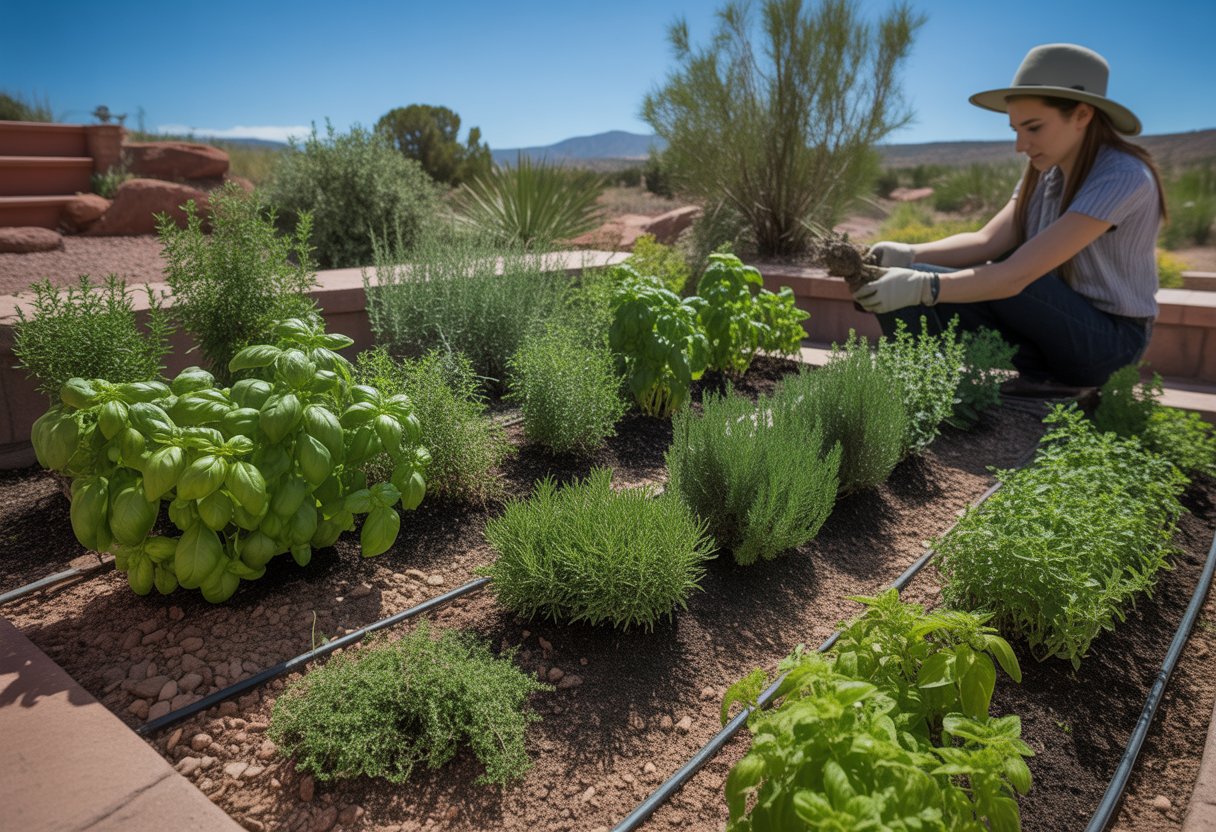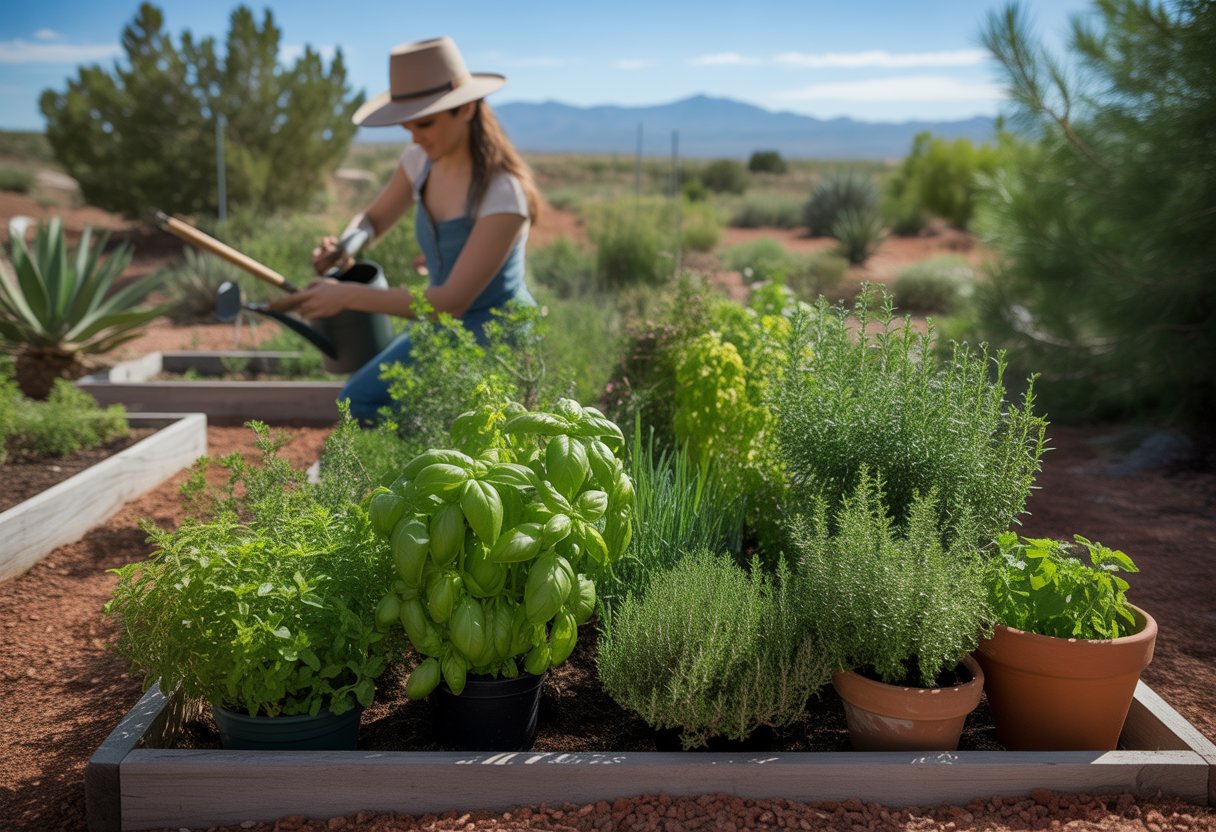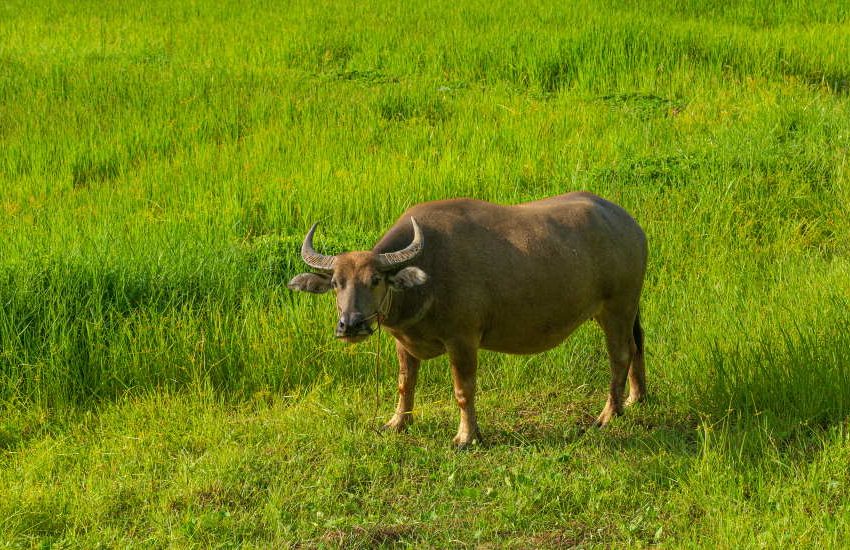Herb Gardening Tips for New Mexico: Essential Advice for Thriving Herbs in Arid Climates
Growing herbs in New Mexico means adapting to dry air and high elevations. Choosing drought-tolerant herbs like rosemary, thyme, and sage gives your garden a real shot, even with limited water.
Understanding soil quality and sunlight makes a big difference.

Give your plants plenty of space and mulch to lock in moisture. If you pay attention to local weather, herb gardening here can be surprisingly productive.
Understanding New Mexico’s Herb Gardening Environment
If you want healthy herbs in New Mexico, you’ve got to work with the dry climate, poor soils, and tricky watering. Folks here deal with temperature swings, gritty soil, and just not enough water, so you have to tweak your approach.
Climate and Seasonal Considerations
New Mexico gets a lot of sun, not much rain, and wild daily temperature swings. Daytime highs can easily top 90°F in summer, then drop 20 or even 30 degrees at night.
Frosts hit from late fall through early spring, so the growing season isn’t very long. Rosemary, thyme, and oregano shrug off the heat and dry air.
But tender herbs like basil hate frost, so you’ll want to start them inside or be ready to cover them up. Most folks wait until mid-April or May, after the last frost, to plant outdoors.
Winter brings dry air and the occasional freeze, so mulching or moving pots inside helps a lot. If summer sun gets too intense, I’d throw up a shade cloth.
Soil Quality and Amendments
Soils here? Usually sandy, alkaline, and not exactly bursting with nutrients. Testing soil pH early is a smart move—herbs like it between 6.0 and 7.0.
Tossing in compost from your pile does wonders for structure and nutrients. Mixing potting soil with native dirt in raised beds helps balance drainage with keeping enough moisture.
If you’ve got heavy clay or compacted soil, don’t skip amending it. Each season, mixing in aged compost keeps things lively.
If your pH is off, a little lime can help bring it back in line.
Watering and Irrigation Needs
Herbs here need regular but not constant watering, since the soil dries out fast. Deep soaks once or twice a week beat shallow sprinkles every day.
Drip irrigation or soaker hoses save water and get it right to the roots. If you’re hand watering, do it early or late to avoid losing too much to evaporation.
Keep an eye on soil moisture—too much water can rot roots, especially for Mediterranean herbs. Grouping herbs by their thirst level makes watering easier.
A good layer of mulch keeps the soil cool and damp, which is always welcome in the heat.
Selecting and Growing the Best Herbs for New Mexico
If you want your herbs to make it through a New Mexico summer, pick varieties that handle heat and dry air. Whether you start from seed or buy seedlings, paying attention to soil and spacing helps.
Choosing Suitable Herb Varieties
Oregano, thyme, and rosemary really thrive here—they’re tough and don’t mind drought. Basil and thai basil like a bit more water, so give them some shade or extra irrigation.
Mint spreads like wildfire, so plant it in a pot or it’ll take over. Cilantro does better in cooler months; it bolts fast in summer but grows nicely in spring and fall.
Picking herbs that are native or adapted to the Southwest saves water and cuts down on fuss. Always check if your herbs want full sun or a little shade.
Starting Herbs from Seedlings and Seeds
Using seedlings gives you a head start, especially with slowpokes like rosemary. You’ll want to harden them off before moving them outside.
Direct seeding works for oregano and thyme—just cover lightly and keep the soil damp until they pop up, which can take anywhere from a week to three. Starting seeds indoors in trays lets you get a jump on the season.
Aim for 65°F–75°F for best germination.
Transplanting and Spacing Guidelines
Transplant on a dry day to avoid root rot. Give your herbs space—oregano and thyme like 12–18 inches, basil and cilantro can squeeze in at 8–12 inches.
Rosemary gets big, so leave at least two feet between plants. Mint needs its own pot or a separate bed, or you’ll regret it.
Spacing matters here—less crowding means less competition for water and nutrients. Mulch helps hold in moisture and shields roots from blazing sun.
Optimizing Herb Garden Layout and Care

Good garden design makes your life easier and keeps plants happy. Layout should help with water, access, and soil—don’t overthink it, but don’t ignore it either.
Utilizing Raised Beds and Containers
Raised beds let you control soil and drainage—super helpful in dry climates like New Mexico. They warm up quickly in spring, which is a bonus.
Containers are handy too; you can move them to chase shade or sun as needed. Using quality potting soil mixed with compost keeps things balanced.
Both options help you manage water better and encourage roots to dig deep. If you group herbs with similar watering needs, you won’t drown your rosemary by accident.
Soil Preparation and Fertilization
Most New Mexico soils need a boost. Blend compost into native soil to help with fertility and moisture.
A mix of 50% native soil, 30% compost, and 20% potting soil usually does the trick. Skip heavy fertilizers; slow-release organic blends work best.
Keep an eye on pH—aim for 6.0 to 7.0. Adjust with lime or sulfur if things get out of whack.
Maintaining Healthy and Productive Herb Gardens

A healthy herb garden in New Mexico takes a bit of vigilance. Regular checks and quick fixes go a long way.
Pest and Disease Management
Watch for aphids, spider mites, and whiteflies—they love herbs here. Spraying with insecticidal soap or neem oil usually keeps them under control.
Fungal stuff like powdery mildew can show up during humid spells. Give your plants space and avoid spraying water on the leaves.
Check for weird spots or twisted leaves, and pull off anything that looks sick. Swapping plant locations and keeping soil healthy also keeps problems at bay.
Pruning, Harvesting, and Storage Tips
Pruning keeps herbs bushy and stops them from getting spindly. If you snip the tips regularly, you’ll usually see more fresh growth—basil, thyme, and oregano especially love this treatment.
It’s best to harvest in the morning, once the dew has dried. That’s when the flavor and oil content hit their peak. Always pick healthy, mature leaves, but don’t take more than a third of the plant at a time. That way, your herbs bounce back stronger.
To keep herbs fresh, wrap them in a damp paper towel and stick them in a sealed plastic bag in the fridge. If you want to dry them, hang bunches upside down in a shaded, breezy spot. That usually keeps the flavor around for months.

